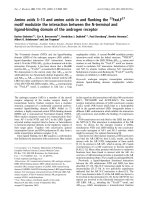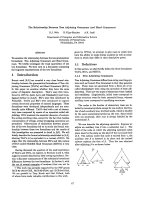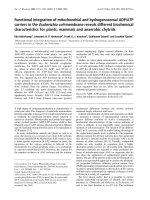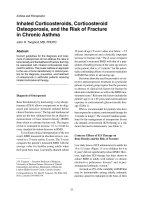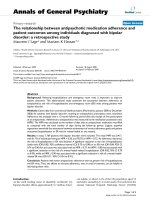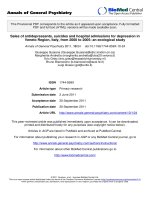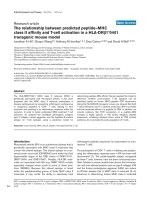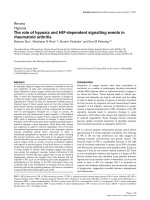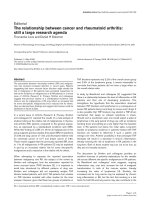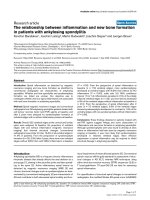Báo cáo y học: " Unique relationship between osteophyte and femoral-tibia component size mismatch in determining polyethylene wear in primary total knee arthroplasty: a case report" pdf
Bạn đang xem bản rút gọn của tài liệu. Xem và tải ngay bản đầy đủ của tài liệu tại đây (874.46 KB, 4 trang )
BioMed Central
Page 1 of 4
(page number not for citation purposes)
Journal of Medical Case Reports
Open Access
Case report
Unique relationship between osteophyte and femoral-tibia
component size mismatch in determining polyethylene wear in
primary total knee arthroplasty: a case report
Manjunath Ramappa* and Andrew Port
Address: James Cook University Hospital, Middlesbrough, UK
Email: Manjunath Ramappa* - ; Andrew Port -
* Corresponding author
Abstract
Introduction: Knee pain is a complex problem that can occur after total knee arthroplasty. One
cause of knee pain may be due to a retained osteophyte, but it is not clear if the retained
osteophyte is sufficient explanation of the pain, as not all patients with retained osteophytes are
symptomatic. In fact, the literature shows that excised osteophytes can also recur over a period of
time, without any symptoms. Therefore a retained osteophyte alone is probably not sufficient to
cause symptoms.
Case presentation: We present a case of intermittent medial knee pain occurring post-primary
total knee arthroplasty, in a patient who underwent several investigations over a period of 5 years.
Radiographs showed an osteophyte in the postero-medial femur along with slight tibial component
overhang which was normal for that knee implant design. The symptoms eventually settled with
excision of only the osteophyte, without altering the tibial component.
Conclusion: A retained osteophyte alone, or tibial component overhang alone, did not seem to
cause significant symptoms in our patient whose symptoms completely settled with excision of the
osteophyte alone, without changing the tibial component. Therefore, it seems that the combination
of retained osteophyte and tibial component overhang (tibia-femoral component size mismatch)
are detrimental and therefore best avoided. This report also emphasises the importance of
meticulous osteophyte excision and avoiding tibial component overhang during knee arthroplasty.
Introduction
This case report discusses knee-implant designs which
have natural femoral-tibial component mismatch with
tibial component overhang, and their unique association
with the surrounding soft tissues, especially retained oste-
ophytes. To our knowledge, this relationship has never
been described before.
Total knee arthroplasty (TKA) is an effective means of pro-
viding pain relief for patients with arthritic knees. There
appears to be rapid and substantial improvement in the
patient's pain, functional status and overall health-related
quality of life in about 90% of cases. However, in a few
patients, pain persists even after arthroplasty. Successful
treatment of this pain depends on the cause [1]. If the
Published: 10 February 2009
Journal of Medical Case Reports 2009, 3:59 doi:10.1186/1752-1947-3-59
Received: 12 August 2008
Accepted: 10 February 2009
This article is available from: />© 2009 Ramappa and Port; licensee BioMed Central Ltd.
This is an Open Access article distributed under the terms of the Creative Commons Attribution License ( />),
which permits unrestricted use, distribution, and reproduction in any medium, provided the original work is properly cited.
Journal of Medical Case Reports 2009, 3:59 />Page 2 of 4
(page number not for citation purposes)
cause is a rarity, it becomes a diagnostic as well as thera-
peutic challenge.
Pain can have a mechanical origin, when it is caused by
loosening or component failure, or it can be continous
when associated with infection. Delayed-onset pain is
usually associated with infection or inflammation (syno-
vitis, tendonitis, wear process) [2].
Variables that affect the wear of a polyethylene bearing in
vivo include the following: wear resistance of the materi-
als as well as the loads, lubrication, sliding distance,
motion pattern, specifics of the design and manufacturing
of the polyethylene component, implantation techniques,
type of wear and amount and type of use of the joint.
We know that component-size mismatch can contribute
to instability after TKA [3]. The component-size mis-
match, however, can be normal for some knee implant
designs. Also, the mismatch can expose more surface area
of that non-articulating polyethylene to surrounding tis-
sues.
Case presentation
A 64-year-old man had undergone right TKA for osteoar-
thritis, with a cruciate-retaining PFC knee system: size 5
femur and 5 tibia with a 10 mm posterior lipped tibial
insert. The initial postoperative period was uneventful
with 0 to 100 degrees of knee flexion. The X-ray (Figure 1)
showed good knee alignment with a slight tibial over-
hang. An untrimmed osteophyte was identified at the pos-
tero-medial femoral condyle. In the first follow-up at 6
weeks, the patient complained of minimal pain and swell-
ing at the anteromedial aspect of the knee. His symptoms
progressed and, at 6 months, the patient underwent an
arthroscopic exploration with washout and samples were
sent for culture & sensitivity. All samples were negative for
any microorganisms. C-reactive protein, white-cell count
and erythrocyte sedimentation rate remained stable and
the pain appeared to settle. At 1-year follow up, the
patient had some medial knee pain which was controlla-
ble. At this stage, he seemed pleased with the outcome of
the surgery. At 3 years, he presented at the clinic again due
to recurrence of medial knee pain. X-rays showed no
changes. Technetium 99 m diphosphonate bone scintigra-
phy showed increased uptake on the delayed phase
mainly in the medial femoral and tibial condyle, which
was inconclusive. Inflammatory markers were again sta-
ble. The pain disappeared shortly after the scan. The pain
recurred once again 5 years after surgery and examination
revealed a tender point at the medial joint line with a pal-
pable lump and good range of flexion. No changes were
observed on a repeat X-ray (Figure 2). At this stage, the
medial joint line was explored which showed a small oste-
ophyte at the postero-medial border of the femur, causing
a localised polyethylene rim wear (non-articulating part)
and localised medial synovial reaction. The osteophyte
was excised. Tibial and femoral components were stable
and hence not revised. At 2 years post-osteophyte excision
(Figure 3), the patient was pain-free and asymptomatic.
Throughout this period, the patient had good knee align-
ment with 0 to 100 degrees of flexion.
Discussion
Intermittent knee pain following arthroplasty poses a sig-
nificant therapeutic challenge. Arthroscopy has a limited
role post-TKA [4]. The clinical triad of effusion, pain and
progressive change in the alignment of the knee which is
characteristic of accelerated polyethylene wear [5] is not
always seen. Some causes of pain reported in the literature
after total knee replacement include remnant soft tissues
[6,7], polyethylene wear, low-grade infection, loosening,
malalignment and over-stuffing. The intermittent exacer-
bation of symptoms is secondary to intermittent synovitis
[8]. A conservative approach and reassurance has had suc-
Initial post-total knee arthroplastyradiograph, showing medial femoral osteophyte (arrow) and tibial component overhang compared to the femoral componentFigure 1
Initial post-total knee arthroplastyradiograph, show-
ing medial femoral osteophyte (arrow) and tibial
component overhang compared to the femoral com-
ponent.
Journal of Medical Case Reports 2009, 3:59 />Page 3 of 4
(page number not for citation purposes)
cess in the management of undiagnosed knee pain in the
past [1].
'Wear' is the removal of material as a result of the relative
motion between two opposing surfaces under load. Wear
particles thus produced activate macrophages, which in
turn release substances resulting in loosening and osteol-
ysis. In a complex mechanical-biological system such as
total knee replacement, there can be many types of wear.
Polyethylene thinning, although commonly seen, is a
complex type of wear.
Persistent osteophytes have been reported to cause prob-
lems occasionally [9,10]. Meticulous resection of the oste-
ophyte is an important technique to prevent post-
operative discomfort in the knee. Small osteophytes can
be easily missed, especially in posterior compartments.
These osteophytes can cause asymmetrical abrasive wear
('Mode-2 wear' [3]) of a non-articulating polyethylene
surface. Asymmetrical wear of a polyethylene bearing can
alter the mechanical axis of the knee and thereby increase
the rate of wear in that compartment because of the
increased load [8,11,12].
Friction is the resistance to movement between two sur-
faces in contact. Frictional torque is the force created as a
result of the friction of bearing. In Mode-2 wear, signifi-
cant frictional torque can accelerate the wear process.
Osteophytes can interact with the polyethylene and sur-
rounding soft tissues to cause a synovial reaction and
wear. If left untreated, osteophytes are known to enlarge
in size. Recurrent osteophytes post-excision are not
uncommon [10]. Retained osteophytes have been known
to cause problems but may also be asymptomatic. There-
fore, there has to be a further contributing factor for this
synovial reaction and wear caused by osteophytes. Some
knee implant designs have slight tibial overhang as com-
pared with the femoral component of same size [13],
exposing more area of the non-articulating polyethylene
surface to surrounding tissues (Figure 1 to Figure 3). Con-
sequently, there is an increased possibility of interaction
between the non-articulating polyethylene and the sur-
rounding tissues, including any persistent osteophytes.
This, in turn, accelerates abrasive polyethylene wear and
Radiograph at 5 years post-total knee arthroplasty, with medial femoral osteophyte (arrow) and tibial component overhang compared to femoral componentFigure 2
Radiograph at 5 years post-total knee arthroplasty,
with medial femoral osteophyte (arrow) and tibial
component overhang compared to femoral compo-
nent.
Radiograph post-medial femoral osteophyte excision (arrow)Figure 3
Radiograph post-medial femoral osteophyte excision
(arrow). Tibial and femoral components are unchanged.
Publish with BioMed Central and every
scientist can read your work free of charge
"BioMed Central will be the most significant development for
disseminating the results of biomedical research in our lifetime."
Sir Paul Nurse, Cancer Research UK
Your research papers will be:
available free of charge to the entire biomedical community
peer reviewed and published immediately upon acceptance
cited in PubMed and archived on PubMed Central
yours — you keep the copyright
Submit your manuscript here:
/>BioMedcentral
Journal of Medical Case Reports 2009, 3:59 />Page 4 of 4
(page number not for citation purposes)
intermittent synovitis [14]. Therefore, retained osteo-
phytes in combination with a large surface area of non-
articulating polyethylene (as in our case, with tibial com-
ponent overhang) can cause this type of synovial reaction
and wear. In our patient, removal of the osteophyte, with-
out changing the tibial implant, was sufficient to clear his
symptoms. Therefore, neither of these two factors in isola-
tion caused detrimental effects, but it is their combination
which created this situation. Therefore, treatment should
be directed at addressing either or both of these issues.
Conclusion
This report provides evidence that the combination of
osteophyte and tibial component overhang can be detri-
mental after TKA. We further show that this can be
resolved by addressing either or both of the detrimental
factors. This report emphasises the importance of meticu-
lous osteophyte excision and avoiding tibial component
overhang during TKA.
Consent
Written informed consent was obtained from the patient
for publication of this case report and accompanying
images. A copy of the written consent is available for
review by the Editor-in-Chief of this journal.
Competing interests
The authors declare that they have no competing interests.
Authors' contributions
MR and AP 1) both made substantial contributions to
conception and design, acquisition and interpretation of
the data; 2) were both involved in drafting the manuscript
or in revising it critically for important intellectual con-
tent; and 3) have both given final approval of the version
to be published.
References
1. Elson DW, Brenkel IJ: A conservative approach is feasible in
unexplained pain after knee replacement. A selected cohort
study. J Bone Joint Surg Br 2007, 89(8):1042-1045.
2. Gonzalez MH, Mekhail AO: The failed total lnee arthroplasty:
evaluation and etiology. J Am Acad Orthop Surg 2004, 12:436-446.
3. Schmalzried TP, Callaghan JJ: A current concepts review – wear
in total hip and knee replacements. J Bone Joint Surg 1999,
81:115-136.
4. Van Mourik JBA, Verhaar JAN, Heijboer RP, Van Kampen A: Limited
value of arthroscopic evaluation and treatment of painful
knee prosthesis of 27 cases. Arthroscopy 1998, 14:877-879.
5. Jones SMG, Pinder IM, Moran CG, Malcolm AJ: Polyethylene wear
in uncemented knee replacements. J Bone Joint Surg Br 1992,
74:18-22.
6. Saouti R, van Royen BJ, Fortanier CM: An impinging remnant
meniscus causing early polyethylene failure in total knee
arthroplasty: a case report. J Med Case Reports 2007, 1:48.
7. Scher DM, Paumier JC, Di Cesare PE: Pseudomeniscus following
total knee arthroplasty as a cause of persistent knee pain. J
Arthroplasty 1997, 12(1):114-118.
8. Cameron HU: Tibial component wear in total knee replace-
ment. Clin Orthop Relat Res 1994, 309:29-32.
9. Dennis DA, Channer M: Retained distal femoral osteophyte. An
infrequent cause of postoperative pain following total knee
arthroplasty. J Arthroplasty 1992, 7(2):193-195.
10. Majewski M, Weining G, Friederich NF: Posterior femoral
impingement causing polyethylene failure in total knee
arthroplasty. J Arthroplasty 2002, 17(4):524-526.
11. Plante-Bordeneuve P, Freeman MAR: Tibial high-density polyeth-
ylene wear in conforming tibiofemoral prostheses. J Bone Joint
Surg Br 1993,
75(4):630-636.
12. Wasielewski RC, Galante JO, Leighty RM, Natarajan RN, Rosenberg
AG: Wear patterns on retrieved polyethylene tibial inserts
and their relationship to technical considerations during
total knee arthroplasty. Clin Orthop Relat Res 1994, 299:31-43.
13. Schai PA, Thornhill TS, Scott RD: Total knee arthroplasty with
the PFC system. Results at a minimum of ten years and sur-
vivorship analysis. J Bone Joint Surg Br 1999, 81(3):558-559.
14. Bosco J, Benjamin J, Wallace D: Quantitative and qualitative
analysis of polyethylene wear particles in synovial fluid of
patients with total knee arthroplasty. A preliminary report.
Clin Orthop Relat Res 1994, 309:11-19.
